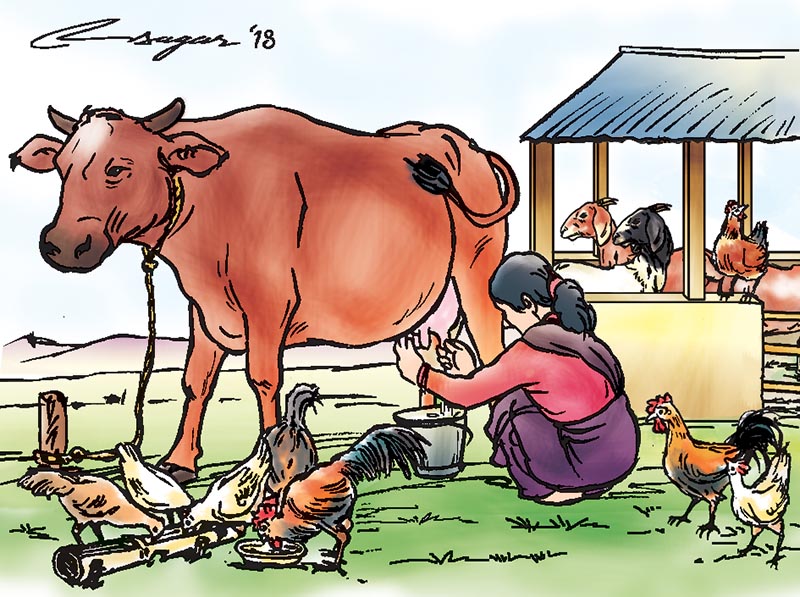Women and livestock: Let’s recognise their roles
Despite women’s involvement in livestock production, their contribution is still under-appreciated in Nepal. It is time to recognise the important role livestock play in tackling poverty and empowering women
The livestock sector plays an important role in Nepal’s economy and is an important sub-sector of our agriculture. The livestock sector is also providing employment opportunity to unemployed and underemployed rural people. The development of this sector has hugely contributed to women empowerment.
Women have been involved in livestock production since time immemorial, especially in our country where domestic animals have been an integral part of the family farming system. Although livestock production patterns differ in different ecological zones and social systems, women’s role has always been central when it comes to care and management of farm animals.
Women make significant contributions to the rural economy. As per Food and Agriculture Organisation statistics, the rural share of total population in the world is 49.4 per cent whereas, in Nepal’s context, it is estimated to be more than 70 per cent. As most of the active population in rural areas has been in foreign employment, rural agricultural as well as livestock management have come under the shoulders of women.
However, the nature and extent of their involvement differ with the variations in the agro-production system.
The mode of female participation in agricultural production depends on the land owning status of farm households. This role ranges from managers to landless labourers. In overall farm production, women’s average contribution is estimated to be 55-66 per cent of the total labour. On an average, women work at farms for 9.9 hours a day against 5.8 hours a day by men, and about 50 per cent of total income is earned by women.
Depending on the region and crops, women’s contribution varies, but they provide pivotal labour from planting to harvesting and post-harvest operations. In general women in tribal and indigenous community households enjoy more decision-making power than in many other Nepali households because of their greater contribution to household incomes.
Increasing women’s access to land, livestock, education, financial services and rural employment would increase their productivity and generate gains in terms of agriculture productions, thereby ensuring food security, economic growth and social welfare.
Achieving gender quality and empowering women in agriculture is crucial for agricultural development and food security. Efforts should be made to promote equal access to resources and opportunities to ensure that agricultural policies and programmes are gender-aware and to make women’s voice heard as equal partners for sustainable development.
Within pastoralist and mixed farming systems, livestock plays an important role in agriculture, especially in high hills and mid-hill areas. In many countries, livestock is one of the most valuable agricultural assets and represent a source of income and wealth accumulation as well as an important source of resistance to shocks.
Draught animals are also the main power for ploughing, land clearing and transportation in many regions. Besides supplying valuable animal protein in the form of milk, meat and egg, livestock also provides manure for crops and vegetables.
So the development of the livestock sector will result in the development of rural economy, particularly in reducing the poverty amongst the weaker sections.
Rural women play a significant role in animal husbandry and are directly involved in most of the operations relating to feeding, breeding, management and health care of livestock.
Women’s involvement in livestock production and development has been a long-standing global tradition. Livestock plays an important role in supporting women in improving their financial situations as they are heavily involved in livestock rearing.
In rural areas, women are engaged in various tasks from dawn to dusk. They share responsibility with men and children for the care of animals. Particular types of activities are more associated with women than men. For example, women often have a prominent role in managing poultry, piggery and dairy animals and in caring for other animals that are housed and fed within the homestead. When tasks are divided, men are more likely to be involved in the construction of houses, herding of grazing animals and marketing products if women’s mobility is constrained.
The influence of women is strong in the use of egg, milk and poultry. These situations vary by culture and context, but in general, men are responsible for keeping and marketing large animals such as cattle, horses, buffaloes, while women tend to control smaller animals such as goats, sheep, pigs and poultry.
Livestock ownership is particularly attractive to women in societies where access to land is restricted to men. While the role of women in small-scale livestock production is well recognised much less has been documented about women’s engagement in intensive production and market chains associated with large commercial enterprises.
Despite women’s involvement in livestock farming, their contribution is still under-appreciated. It is time to recognise the important role livestock play in tackling poverty and empowering women. Economically empowered women will mean a fair and equitable society.






